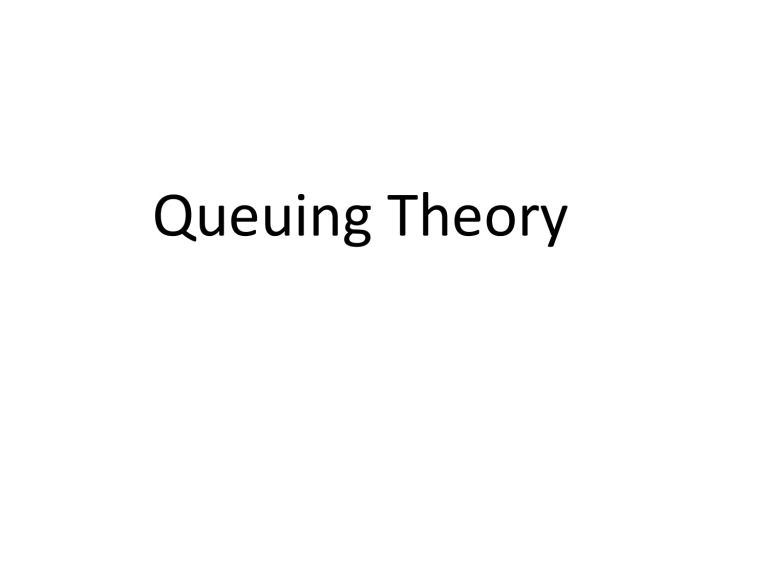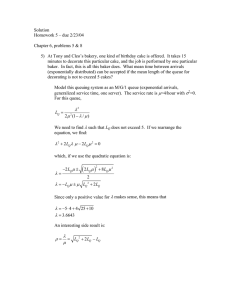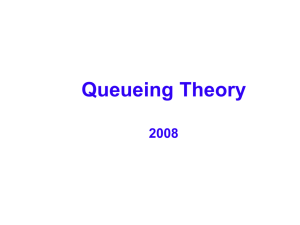
Queuing Theory Introduction Queuing theory is one of the most widely used quantitative analysis techniques. The three basic components are: Arrivals Service facilities Actual waiting line Waiting Line Costs Queuing analysis includes: Determining the best level of service for an organization. Analyzing the trade-off between cost of providing service and cost of waiting time. Finding the service level that minimizes the total expected cost. Queuing Costs and Service Levels Optimal Service Cost of Operating Service Facility Level Total Expected Cost Cost of Providing Service Cost of Waiting Time Service Level Characteristics of a Queuing System Arrival Characteristics Size of the calling population Pattern of arrivals Behavior of arrivals Waiting Line Characteristics Queue length Queue discipline Service Facility Characteristics Configuration of the queuing system Service time distribution Arrival Characteristics of a Queuing System Calling Population: Unlimited (infinite) Limited (finite) Arrival Pattern Randomly Poisson Distribution Arrival Characteristics: Poisson Distribution 0 1 2 3 4 5 6 7 8 9 10 1 1 X .30 .25 .20 .15 .10 .05 .00 P(X), = 4 P(X) .35 .30 .25 .20 .15 .10 .05 .00 P(X) P(X) P(X), = 2 e x X! 0 1 2 3 4 5 6 7 8 9 10 1 1 X Arrival Characteristics of a Queuing System (continued) Behavior of arrivals: Join the queue, and wait till served. Balk; refuse to join the line. Renege; leave the line. Jockeying; move from one queue to another queue. Waiting Line Characteristics of a Queuing System Waiting Line Characteristics: Length of the queue Limited Unlimited (assumed) Service priority/Queue discipline FIFO (assumed) Other Waiting Line Characteristics of a Queuing System (continued) Service Facility Characteristics Number of channels (servers) Single Multiple Number of phases in service system (customer stations) Single (1 stop) Multiple (2+ stops) Service time distribution Negative exponential Other Service Characteristics: Queuing System Configurations Queue Service facility arrivals Single Channel, Single Phase Service Facility Queue Facility 1 arrivals Single Channel, Multi-Phase Facility 2 Service Characteristics: Queuing System Configurations Service facility 1 Queue arrivals Service facility 2 Multi-Channel, Single Phase Queue arrivals Multi-Channel, Multiphase Phase Service facility 3 Type 1 Service Facility Type 2 Service Facility Type 1 Service Facility Type 2 Service Facility Service Characteristics of a Queuing System Service Time Patterns: Negative exponential probability distribution Other distribution Service Time Characteristics: Exponential Distribution f(x) μe μx for x 0, μ 0 Probability (for Intervals of 1 Minute) μ Average Number Served Per Minute Average Service Time of 20 Minutes Average Service Time of 1 Hour 30 60 90 120 150 180 X Kendall Notation for Queuing Models Kendall notation consists of a basic three-symbol form. Arrival Service Time Number of Service Distribution Distribution Channels Open Where, M = Poisson distribution for the number of occurrences (or exponential times) D = Constant (deterministic rate) G = General distribution with mean and variance known Single channel with Poisson arrivals and exponential service times M/M/1 Assumptions: M/M/1 Model 1. Queue discipline: FIFO 2. No balking or reneging 3. Independent arrivals; constant rate over time 4. Arrivals: Poisson distributed 5. Service times: average known 6. Service times: negative exponential 7. Average service rate > average arrival rate Operating Characteristics of Queuing Systems Average time each customer spends in the queueW Average length of the queue L Average time each customer spends in the system Ws Average number of customers in the system Probability that the service facility will be idle L s q s P0 1 Utilization factor for the system Probability of a specific number of customers inthe system Pn 1 n Operating Characteristic Equations: M/M/1 Average number in system, L s Average time in system, Ws - 1 - 2 Average number in queue, L q - Average time waiting, Wq - Utilizatio n Factor, Percent Idle, P0 1 Probability the number of customers is > k, Pn k k 1 Car Wash Example: M/M/1 Assume you are planning a car wash to raise money for a local charity. You anticipate the cars arriving in a single line and being serviced by one team of washers. Based on historical data, you believe cars will arrive every 30 minutes, and the team can wash a car in about 20 minutes. The arrival rates follow a Poisson distribution and the service rates are exponentially distributed. What are the operating characteristics for this system? Car Wash Example: Operating Characteristics = 2 cars arriving per hour μ = 3 cars serviced per hour Ls Ws Lq Wq Po => => => => => => ? cars in the system on average ? hour that an average car spends in the system ? cars waiting on average ? hours is average wait ? percent of time car washers are busy ? probability that there are 0 cars in the system Car Wash Example: Operating Characteristics Solution = 2 cars arriving per hour μ= 3 cars serviced per hour Ls =2/(3-2) => Ws = 1/(3-2) => Lq = 2^2/3(3-2) => Wq = 2/3(3-2) => = 2/3 => P(0) = 1 – (2/3) => 2 cars in the system on average 1 hour that an average car spends in the system 1.33 cars waiting on average .67 hours is average wait .67 percent of time washers are busy .33 probability that there are 0 cars in the system



